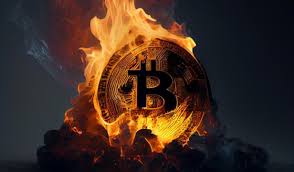Understanding Cryptocurrency Burning
Cryptocurrency burning is a process where digital tokens (also known as coins) are permanently removed from circulation.
This is done by sending them to a special wallet address that cannot be accessed or used for any transactions, except for receiving coins. Since no one has the private keys to this wallet, the tokens sent there are essentially lost forever.
Key Takeaways
- Burning cryptocurrency means sending tokens to an inaccessible wallet address.
- These special wallets are often called “burner,” “eater,” or “null” addresses.
- The purpose of burning tokens is to reduce the total supply of a cryptocurrency, thereby limiting its availability.
- Some blockchains use burning to help increase a coin’s market value, while others use it as a requirement for miners to prove their commitment and earn the right to mine new blocks.
How Does Cryptocurrency Burning Work?
When someone owns cryptocurrency, they have a unique wallet address that allows them to send and receive digital tokens.
This is similar to how an email address works—you can send and receive emails as long as you have access to the account. A cryptocurrency wallet works the same way, but instead of emails, it holds digital assets.
Burning a cryptocurrency means transferring a token to a wallet address that cannot be used for any transactions other than receiving funds. These special wallets—often called burner, eater, or null addresses—are designed in such a way that no one can access the tokens inside.
Since wallet addresses store the cryptographic keys needed to manage coins, and burner wallets have no known keys, the tokens sent there are permanently removed from circulation.
Practical Uses of Crypto Burning
The concept of removing assets from circulation to influence value is not new. Traditional financial systems, such as central banks, regulate the supply of money to control inflation and purchasing power. Similarly, cryptocurrency burning has several real-world applications.
1. Increasing the Value of a Cryptocurrency
In the stock market, publicly traded companies sometimes buy back their shares to reduce the number of shares in circulation.
This is done in the hope of increasing the stock price and improving the company’s financial outlook. However, stock buybacks do not always have the intended effect and can sometimes lead to negative outcomes.
In the cryptocurrency world, some developers burn tokens to create scarcity and potentially increase demand. By reducing the total supply, they hope to make the remaining tokens more valuable.
While burning tokens can contribute to price increases, there is no guarantee that this will always work. The actual effect depends on investor confidence, market conditions, and demand for the token.
2. Proof of Burn (PoB) Mechanism
Proof of Burn (PoB) is a type of consensus mechanism used in blockchain networks to validate transactions and maintain security. A consensus mechanism is a set of rules that help multiple computers (nodes) in a blockchain agree on the state of the network.
PoB is sometimes referred to as a proof-of-work system without excessive energy consumption. It requires miners to burn tokens as proof of their commitment to the network.
In return, they are granted the right to mine new blocks and earn rewards. Unlike Bitcoin’s proof-of-work (PoW) system, which requires significant computational power and energy, PoB reduces competition among miners, leading to lower energy consumption.
To participate in PoB, miners must send a specific amount of cryptocurrency to a burner address. This permanently removes the tokens from circulation.
Depending on the blockchain’s rules, miners may need to burn the network’s native currency or an external cryptocurrency like Bitcoin. After burning tokens, the miner gains permission to validate transactions and earn rewards in the blockchain’s native token.
Does Burning Crypto Increase Its Price?
Cryptocurrency burning effectively decreases the total number of tokens available in the market. In theory, this could lead to a price increase, just as corporate stock buybacks can boost stock prices.
However, whether burning has a positive or negative effect depends on several factors, including market sentiment, demand for the token, and overall investor confidence.
If investors see burning as a valuable strategy, the reduced supply might create scarcity, leading to higher prices. On the other hand, if burning is perceived as a manipulation tactic or fails to generate interest, the price may not increase or could even decline.
How to Burn Cryptocurrency
If someone wants to remove unwanted cryptocurrency from circulation, they can do so by sending it to a burner, null, or eater address.
These wallet addresses are specifically designed to receive tokens but do not allow anyone to withdraw or access them. Once a token is sent to such an address, it is permanently destroyed and cannot be recovered.
Final Thoughts
Cryptocurrency burning is a process where tokens are permanently removed from circulation by sending them to an inaccessible wallet. This is often compared to burning physical money, as it effectively reduces the supply of the currency.
The main reason for burning tokens is to create scarcity, with the goal of increasing demand and price. However, token burning can also be used as part of a blockchain’s internal operations, such as in proof-of-burn mining.
While the practice is often promoted as beneficial for a cryptocurrency’s ecosystem, some argue that it is merely a market manipulation strategy disguised as an improvement for the community.
Ultimately, the success of token burning depends on various market factors, and its impact on price is not always guaranteed.
Join Gen Z official Whatsapp Channel To Stay Updated On time the ongoing situation https://whatsapp.com/channel/0029VaWT5gSGufImU8R0DO30


